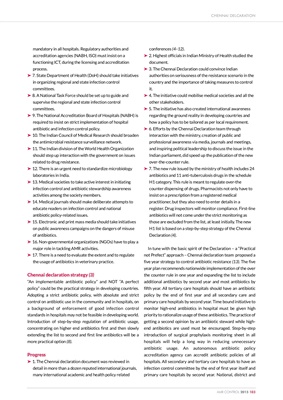
mandatory in all hospitals. Regulatory authorities and
accreditation agencies (NABH, ISO) must insist on a
functioning ICT, during the licensing and accreditation
process.
‰ 7. State Department of Health (DoH) should take initiatives
in organizing regional and state infection control
committees.
‰ 8. A National Task Force should be set up to guide and
supervise the regional and state infection control
committees.
‰ 9. The National Accreditation Board of Hospitals (NABH) is
required to insist on strict implementation of hospital
antibiotic and infection control policy.
‰ 10. The Indian Council of Medical Research should broaden
the antimicrobial resistance surveillance network.
‰ 11. The Indian division of the World Health Organization
should step up interaction with the government on issues
related to drug resistance.
‰ 12. There is an urgent need to standardize microbiology
laboratories in India.
‰ 13. Medical societies to take active interest in initiating
infection control and antibiotic stewardship awareness
activities among the society members.
‰ 14. Medical journals should make deliberate attempts to
educate readers on infection control and national
antibiotic policy-related issues.
‰ 15. Electronic and print mass media should take initiatives
on public awareness campaigns on the dangers of misuse
of antibiotics.
‰ 16. Non-governmental organizations (NGOs) have to play a
major role in tackling AMR activities.
‰ 17. There is a need to evaluate the extent and to regulate
the usage of antibiotics in veterinary practice.
Chennai declaration strategy (3)
"An implementable antibiotic policy" and NOT "A perfect
policy" could be the practical strategy in developing countries.
Adopting a strict antibiotic policy, with absolute and strict
control on antibiotic use in the community and in hospitals, on
a background of enforcement of good infection control
standards in hospitals may not be feasible in developing world.
Introduction of step-by-step regulation of antibiotic usage,
concentrating on higher end antibiotics first and then slowly
extending the list to second and first line antibiotics will be a
more practical option (8).
Progress
‰ 1. The Chennai declaration document was reviewed in
detail in more than a dozen reputed international journals,
many international academic and health policy related
conferences (4-12).
‰ 2. Highest officials in Indian Ministry of Health studied the
document.
‰ 3. The Chennai Declaration could convince Indian
authorities on seriousness of the resistance scenario in the
country and the importance of taking measures to control
it.
‰ 4. The initiative could mobilise medical societies and all the
other stakeholders.
‰ 5. The initiative has also created international awareness
regarding the ground reality in developing countries and
how a policy has to be tailored as per local requirement.
‰ 6. Efforts by the Chennai Declaration team through
interaction with the ministry, creation of public and
professional awareness via media, journals and meetings,
and inspiring political leadership to discuss the issue in the
Indian parliament, did speed up the publication of the new
over-the-counter rule.
‰ 7. The new rule issued by the ministry of health includes 24
antibiotics and 11 anti-tuberculosis drugs in the schedule
H1 category. This rule is meant to regulate over-the
counter dispensing of drugs. Pharmacists not only have to
insist on a prescription from a registered medical
practitioner, but they also need to enter details in a
register. Drug inspectors will monitor compliance. First-line
antibiotics will not come under the strict monitoring as
those are excluded from the list, at least initially. The new
H1 list is based on a step-by-step strategy of the Chennai
Declaration (4).
In tune with the basic spirit of the Declaration - a "Practical
not Prefect" approach - Chennai declaration team proposed a
five year strategy to control antibiotic resistance (13). The five
year plan recommends nationwide implementation of the over
the counter rule in one year and expanding the list to include
additional antibiotics by second year and most antibiotics by
fifth year. All tertiary care hospitals should have an antibiotic
policy by the end of first year and all secondary care and
primary care hospitals by second year. Time bound initiative to
monitor high-end antibiotics in hospital must be given high
priority to rationalize usage of these antibiotics. The practice of
getting a second opinion by an antibiotic steward while highend
antibiotics are used must be encouraged. Step-by-step
introduction of surgical prophylaxis monitoring sheet in all
hospitals will help a long way in reducing unnecessary
antibiotic usage. An autonomous antibiotic policy
accreditation agency can accredit antibiotic policies of all
hospitals. All secondary and tertiary care hospitals to have an
infection control committee by the end of first year itself and
primary care hospitals by second year. National, district and
CHENNAI DELCARATION
AMR CONTROL 2015 103